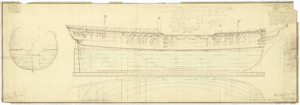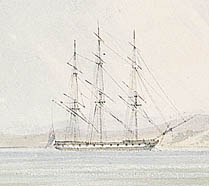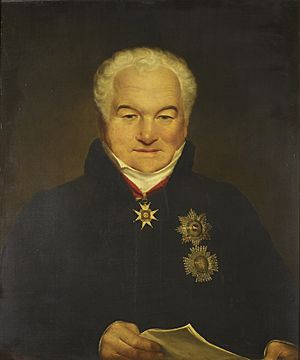HMS Artois (1794) facts for kids

Design of HMS Artois
|
|
Quick facts for kids History |
|
|---|---|
| Name | HMS Artois |
| Ordered | 28 March 1793 |
| Cost | £20,757 |
| Laid down | March 1793 |
| Launched | 3 January 1794 |
| Commissioned | December 1793 |
| Fate | Wrecked off Île de Ré, 31 July 1797 |
| General characteristics | |
| Class and type | Artois-class fifth-rate frigate |
| Tons burthen | 9965⁄94 (bm) |
| Length |
|
| Beam | 39 ft 2+1⁄2 in (12 m) |
| Draught |
|
| Depth of hold | 13 ft 9 in (4.2 m) |
| Propulsion | Sails |
| Complement | 270 |
| Armament |
|
HMS Artois was a fast frigate (a type of warship) in the Royal Navy. She was designed by Sir John Henslow and launched in 1794. Artois was the first ship of her kind, known as the Artois-class.
She spent most of her time in the English Channel, working with squadrons led by Edward Pellew and John Borlase Warren. Her most famous moment was capturing the French frigate La Révolutionnaire in 1794. Artois also took part in other important events, like the attempt to invade France in 1795. She was very active, patrolling the coast of France and capturing many enemy ships. Sadly, Artois was wrecked on July 31, 1797, near Île de Ré, but luckily, everyone on board was saved.
Contents
Building a Warship: HMS Artois
Artois was a 38-gun frigate, meaning she carried 38 cannons. She was part of the "fifth-rate" class of ships. Her design was created by Sir John Henslow. These ships were ordered at the start of the French Revolutionary War to give the Royal Navy new, modern warships.
Artois was the first ship of her class to be built. Most ships in her class, including Artois, were made from strong oak wood. Her design was an improvement over older frigates. They made Artois longer at the front to make her faster and more stable in the water. Even with these changes, the ships still pitched (rocked back and forth) a lot in rough seas. Despite this, the Artois-class ships became known as "crack frigates." They were perfect for their job: big enough to fight French frigates and fast enough to stay on patrol in any weather.
Artois was ordered on March 28, 1793, and built in Rotherhithe. She was launched on January 3, 1794. Her main deck was about 44.6 meters (146 feet 3 inches) long. She was about 11.9 meters (39 feet 2.5 inches) wide. Her fitting out was finished on March 30, 1794. Later, in November 1794, eight 32-pounder carronades (short, powerful cannons) were added to Artois and her sister ships. This made some people call them "44-gun frigates." In 1796, the ship's crew grew from 270 to 284 sailors.
Life at Sea: Artois's Service
1794: Early Missions and Big Battles
Artois began her service in December 1793 under Captain Lord Charles Fitzgerald. Soon after, Captain Edmund Nagle took command. In April 1794, Artois helped at the siege of Bastia. Here, ships of Admiral Lord Hood's fleet stopped supplies from reaching the French soldiers in Bastia, forcing them to give up.
After this, Artois moved to the English Channel. She joined Commodore John Borlase Warren's squadron, which was blocking the French port of Brest. She spent most of her time patrolling around Audierne Bay.
Destroying Le Volontaire
On August 23, Artois helped destroy the French frigate Le Volontaire. Warren's squadron found the French frigate near the Penmarks. The British ships chased Le Volontaire, forcing her to anchor close to shore. The British attacked, and Le Volontaire had to cut her anchor ropes. This caused her to run aground (get stuck on the shore). Her crew left the ship, and she was destroyed.
The same British squadron then found two more French ships, L'Alerte and Espion. These ships also ran aground to avoid capture. The British boarded them and took some prisoners. L'Alerte was lost, but the French managed to save Espion. The squadron continued its patrols, capturing other smaller ships and recapturing British merchant vessels.
Capturing La Révolutionnaire
In October, Artois was part of Edward Pellew's squadron. On October 21, they found the French frigate La Révolutionnaire near Ushant. The British ships chased her. Artois was faster than the others and caught up to La Révolutionnaire first.
The two frigates fought for about 40 minutes. Eight French sailors and three British sailors were killed. When Diamond, another British frigate, came closer, La Révolutionnaire surrendered to Artois. The French ship had only been launched a few weeks before, and her new crew refused to keep fighting. Pellew said that Artois would have won even without help. The captured French frigate was added to the Royal Navy as HMS Révolutionnaire. Captain Nagle was knighted (given a special honor) for his bravery.
1795: More Captures and an Invasion Attempt
After this big victory, Artois rejoined Commodore Warren's squadron. On February 18, 1795, they found a French convoy (a group of ships traveling together) of twenty ships near Oléron. The convoy was protected by a French frigate called Néréide. The British squadron chased the convoy, capturing several ships and destroying others. These ships were carrying food and clothes for the French army.
Between February and March, the squadron was very busy, capturing many more French merchant ships. On April 15, Artois chased and captured the 26-gun French corvette Le Jean Bart. The next day, Artois and another frigate, Galatea, captured the 16-gun sloop Expedition. Artois also captured two sloops carrying fish.
Between June and October, Artois took part in a failed attempt by French royalists (people who supported the old French king) to invade France at Quiberon. Artois was present at the Battle of Groix on June 23. She shared in the capture of three large French warships, even though she wasn't directly involved in the fighting. Artois and other ships helped protect the convoy carrying the invasion force. The troops landed successfully, but after losing battles against the French revolutionary soldiers, they had to be evacuated back to England. Artois and the other ships provided covering fire to help the royalists escape.
1796: Blockades and Ship Destruction
After the failed invasion, Artois went back to her usual duties of blocking ports and patrolling. She captured more ships in March 1796. On March 20, Artois and other frigates found a large French convoy of seventy ships near Pointe du Raz. The convoy was guarded by several French frigates and a corvette. Artois and Pomone quickly captured four of the convoy ships.
The French warships tried to protect the convoy, exchanging fire with the British ships. The British tried to break through the convoy but couldn't bring them to another big battle. They only captured one armed store ship, Etoile. The French warships and most of the convoy escaped. Commodore Warren was criticized for not pushing his advantage more. Artois continued to capture more French merchant ships in April, May, and August.
Destroying Andromaque
On August 22, Artois and her squadron were near the Gironde river when they saw the French frigate Andromaque. Andromaque was trying to enter the river. Galatea chased her, followed by Pomone and Anson. Artois and Sylph went to check on two other ships. The chase continued all night.
By morning, Andromaque was very close to shore. She tried to escape but ran aground (got stuck) near Arcachon, losing all her masts. Artois, Galatea, and Sylph sent their boats to take control of the frigate. Many of Andromaque's crew jumped into the sea to avoid capture, while others walked to shore when the tide went out. That evening, boats from Sylph set fire to Andromaque, and she exploded.
On November 2, Artois helped capture the 12-gun privateer Le Franklin. In December, Artois had a string of successes, capturing several French and Spanish merchant ships.
1797: Final Missions
Artois's squadron continued to be active in 1797, capturing more ships in February and March, and recapturing a British whaling ship in April. On July 16, they found a French convoy of fourteen ships protected by the frigate La Calliope and two corvettes. The corvettes escaped, but La Calliope couldn't get away.
To avoid being captured, La Calliope cut down her masts and ran herself aground on the Penmarks. To stop the French from taking supplies from La Calliope, Anson and Sylph fired cannons at the stranded ship. Artois and Pomone watched from a distance. La Calliope broke apart on the rocks on July 18.
The End of Artois
On July 31, 1797, Artois was wrecked. She hit a sandbank near the Ballieu rocks on the north-west coast of Île de Ré. She was trying to scout the harbor of La Rochelle. Luckily, the entire crew was saved by the ship Sylph. The ship's pilot and master (the person in charge of navigation) were blamed for causing the wreck because they were not careful enough.
Captured Ships
Artois and her squadron captured or helped destroy many enemy ships during her service. Here are some of them:
| Vessels captured or destroyed for which Artois's crew received full or partial credit | |||||
|---|---|---|---|---|---|
| Date | Ship | Nationality | Type | Fate | Ref. |
| 23 August 1794 | Le Volontaire | 36-gun frigate | Destroyed | ||
| 23 August 1794 | L'Alerte | 12-gun brig | Destroyed | ||
| 26 August 1794 | Queen | Merchant vessel | Recaptured | ||
| 26 August 1794 | Donna Maria | Merchant vessel | Recaptured | ||
| 7 September 1794 | Le Quartidi | Cutter | Captured | ||
| 16 September 1794 | Haesingeland | Merchant vessel | Recaptured | ||
| 21 October 1794 | La Révolutionnaire | 44-gun frigate | Captured | ||
| 18 February 1795 | Not recorded | Merchant brig | Destroyed | ||
| 18 February 1795 | Not recorded | Merchant brig | Destroyed | ||
| 18 February 1795 | Not recorded | Merchant brig | Destroyed | ||
| 18 February 1795 | Not recorded | Merchant brig | Destroyed | ||
| 18 February 1795 | Not recorded | Merchant brig | Destroyed | ||
| 18 February 1795 | Not recorded | Merchant brig | Destroyed | ||
| 18 February 1795 | Not recorded | Merchant brig | Destroyed | ||
| 18 February 1795 | Not recorded | Merchant brig | Destroyed | ||
| 18 February 1795 | Not recorded | Merchant brig | Destroyed | ||
| 18 February 1795 | Not recorded | Merchant brig | Destroyed | ||
| 18 February 1795 | Not recorded | Lugger | Destroyed | ||
| 13 February-2 March 1795 | Le Pierre | Merchant vessel | Captured | ||
| 13 February-2 March 1795 | Le Petit Jean | Merchant vessel | Captured | ||
| 13 February-2 March 1795 | Le Deux Freres | Merchant vessel | Captured | ||
| 13 February-2 March 1795 | La Liberte | Merchant vessel | Captured | ||
| 13 February-2 March 1795 | Le Adelaide | Merchant vessel | Captured | ||
| 13 February-2 March 1795 | L'Aimable | Merchant vessel | Captured | ||
| 13 February-2 March 1795 | La Coureause | Merchant vessel | Captured | ||
| 13 February-2 March 1795 | L'Aimable Madelaine | Merchant vessel | Captured | ||
| 13 February-2 March 1795 | La Pacquebot de Cayenne | Merchant vessel | Captured | ||
| 13 February-2 March 1795 | La Biche | Merchant vessel | Captured | ||
| 15 April 1795 | Le Jean Bart | 26-gun corvette | Captured | ||
| 16 April 1795 | Expedition | 16-gun sloop | Captured | ||
| 16 April 1795 | Maria Francis Fidilla | Merchant vessel | Captured | ||
| 16 April 1795 | Not recorded | Merchant sloop | Captured | ||
| 16 April 1795 | Not recorded | Merchant sloop | Captured | ||
| 23 June 1795 | Alexander | 74-gun ship-of-the-line | Captured | ||
| 23 June 1795 | Tigre | 74-gun ship-of-the-line | Captured | ||
| 23 June 1795 | Formidable | 74-gun ship-of-the-line | Captured | ||
| 6 March 1796 | Sultana | Merchant vessel | Captured | ||
| 7 March 1796 | Nancy | Merchant vessel | Captured | ||
| 20 March 1796 | L'Etoile | 28-gun armed store ship | Captured | ||
| 20 March 1796 | Illier | Merchant vessel | Captured | ||
| 20 March 1796 | Don de Dieu | Merchant brig | Captured | ||
| 20 March 1796 | Paul Edward | Merchant brig | Captured | ||
| 20 March 1796 | Felicite | Merchant brig | Captured | ||
| 20 March 1796 | Not recorded | Merchant vessel | Captured | ||
| 7–13 April 1796 | La Marie | Merchant vessel | Captured | ||
| 7–13 April 1796 | L'Union | Merchant vessel | Captured | ||
| 7–13 April 1796 | La Bonne | Merchant vessel | Captured | ||
| 7–13 April 1796 | Not recorded | Merchant brig | Captured | ||
| 14 May 1796 | Pacific | Merchant vessel | Captured | ||
| 22 May 1796 | Lodoiska | Merchant vessel | Captured | ||
| 25 May 1796 | Fantasie | Merchant vessel | Captured | ||
| 16 August 1796 | Charlotte | Chasse-marée | Captured | ||
| 16 August 1796 | Veronique | Chasse-marée | Captured | ||
| 23 August 1796 | Andromaque | 32-gun frigate | Destroyed | ||
| 2 November 1796 | Le Franklin | 12-gun privateer | Captured | ||
| 11 December 1796 | Le Providence | Chasse-marée | Captured | ||
| 11 December 1796 | La Maria Theresa | Chasse-marée | Captured | ||
| 14 December 1796 | Not recorded | Merchant brig | Captured | ||
| 17 December 1796 | Divina Pastora | Merchant brig | Captured | ||
| 15 February 1797 | Le Jean Amie | Merchant vessel | Captured | ||
| 16 March 1797 | Nordzee | Merchant vessel | Captured | ||
| 25 April 1797 | Mary | Whaler | Recaptured | ||
| 17 July 1797 | La Calliope | 28-gun frigate | Destroyed | ||



